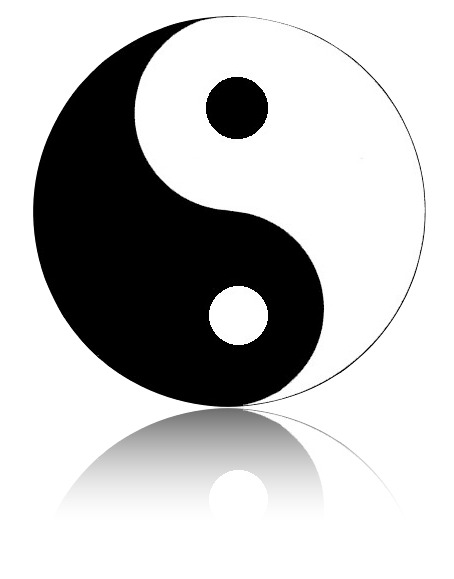Karma is a word which has entered the English language, but is often misused to mean fate (as in cause and effect), when the actual meaning of Karma is to act, action, performance. Karma can also be the seeds and the fruits of action.
A useful way of thinking about Karma is the way we inter-act with and re-act to our world. The Mandala Chart gives us some ways in which we can better gauge the process, and work to create good Karma for ourselves and others.

The Yin-Yang symbol shows the interaction of phenomena, and the interplay of opposites which creates our world. The key message is that you reap as you sow. Therefore if we want to achieve positive results, it makes sense to think, speak, and act positively.
This is a challenge. It takes patience and perspective, because you cannot cheat the process. If you are too attached to the results, then you may be tempted to seek shortcuts, and short work produces short results. Attachment is based on inflexible focus. It takes a flexible point of view and to see all sides of a problem, and come up with creative solutions.
Karma, Connections, and Chaos Theory
There is also collective Karma, which is often thought of as collective fate, but more constructively can be interpreted as collective action. Global warming, the skidding economy, religious rivalry, these are issues that have an impact on the very environment we live in. They are so immense that it seems you cannot do much about them as an individual.
Isolated effort against vast forces seems putting a drop in the ocean. However, the good actions that you perform have a cumulative effect on you and your personal environment, as well as a positive influence on others. You can change, even if the world around you does not.
Moreover, things are connected in ways that are not always obvious. The Greek philosopher Heraclitus (540~480 BC) said that, a hidden connection is stronger than an obvious one.
James Burke, the science historian and creator-host of the popular BBC series Connections (http://en.wikipedia.org/wiki/Connections_%28TV_series%29), showed throughout the series how things and people which seem totally unrelated are often connected by only a few degrees of separation. Napoleon may seem an odd companion for computers, but Burke traces the path of influence from Napoleon’s invasion of Egypt, to the French soldiers discovery of Middle Eastern carpets, which triggered a fashion boom for such carpets in France, and a new technology for weaving them quickly on a loom that used cards with holes punched in them to block and pass the colored woven strands and control the intricate patterns, which spawned the punch-card tabulator invented for the purpose of automating the US census, which then led to the use of keypunch cards for early computers and data processing, and the rest is history.
Edward Lorenz, father of the Chaos theory and the butterfly effect, as an MIT Meteorologist in 1972 raised the possibility that the flap of a butterfly’s wings in Brazil might trigger a tornado in Texas. While the mathematics may be well beyond the average person, Chaos Theory remains a powerful metaphor for the hidden connections in our world.
How can you apply the Butterfly Effect?
Even when the connections are not obvious, it is possible to take small actions which use the butterfly effect to create good Karma. Here are 8 things which you can do to have a more positive effect.
1. Don’t make a bad situation worse. How you respond to things can turn the situation around.
2. Recognize your responsibility. You contribute to and participate in making the situation what it is.
3. Engage in possibility thinking. Your ideas are a powerful force as a co-creator.
4. Plant positive seeds. Perform small acts of kindness. Take the extra step.
5. Engage in powerful rituals. The habits and routines which you perform on a regular basis can build your bank of resources.
6. Find ways to leverage and multiply. Consider what factors make the biggest difference.
7. Learn lessons vicariously. You don’t have to repeat other’s mistakes, you can learn from their experience.
8. Remember that Karma means action. Good Karma is the result of actions in the present, not just consequences from the past.
I have prepared a Mandala Chart for Karma Connections, which you can download as a PDF, and use to develop your own butterfly effect.
http://www.williamreed.jp/wp-content/uploads/2010/08/KARMA-CONNECTIONS.pdf
Despite our best efforts to remain positive, there are times when Collective Karma or Karmic consequences can bear hard on us. There is a way to remain resilient, and lessen the effects of stress, if you apply a simple principle. The strength of a chain is measured in its weakest link. If you bear the loads of life with narrow and inflexible focus, then eventually your chain will feel the strain and may break. The strength of a net is its power to be flexible, to absorb and distribute the load, and also to cast it off. Think of the resilience and power of a tennis racquet to send the ball with speed and precision.
It all depends on how fully and positively you engage. The Yin-Yang symbol is a symbol for full engagement, resembling two question marks in a reflective embrace. Curiosity is a driving force for flexible focus. You can use this image to constantly search for ways to engage more positively and more powerfully in your life.


